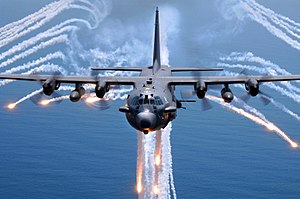G-1 Deathstar: Difference between revisions
No edit summary |
m (1 revision imported) |
Latest revision as of 22:31, 22 March 2019
This article is incomplete because it is pending further input from participants, or it is a work-in-progress by one author. Please comment on this article's talk page to share your input, comments and questions. Note: To contribute to this article, you may need to seek help from the author(s) of this page. |
| G1 Deathstar | |
|---|---|
 G-1 Deathstar deploys flares at the 2006 Emerald Bay Air Show | |
| General information | |
| Type | Fixed-wing ground-attack and close air support gunship |
| Manufacturer | Postill Aerospace Systems |
| Status | In service |
| History | |
| Introduction date | 5 July 1963 |
| Retired | G-1A: 1990 G-1B: 2012 |
The Postill G-1 is a heavily armed ground-attack aircraft variant of the D3 Pelegiad cargo plane that serves in the Imperial Castarcian Air Force. The G-1 can also function as a missile carrier and a refueling aircraft for smaller aircraft such as the Spearfightersand the CPAC-AJ/17 aircraft in service with the ICAF.
The current G-1C Deathstars in active service are currently assigned to the 13th Tactical Ground Attack Squadron, popularly known as the "Angels of Annihilation", and are equipped with an Imperial Ordnance 30mm "Vengeance" cannon, a 105mm Imperial Ordnance cannon (heavily modified variant of the same gun seen on the Comrade Mk5c and Mk6 tanks) and finally as far as offensive weaponry is concerned, a 40mm cannon.
Development
During the 1960s, both Emperor Jeremy I and High Admiral Gerrard Steele were enamoured with the idea of a fixed-wing heavy gunship that could provide close air support for ground forces. A fixed wing aircraft, in the eyes of High Command, had more potential than a helicopter, as it could be faster, carry more munitions, and have a far superior range, allowing it to loiter for longer periods of time and continue to provide firepower.
The Imperial Castarcian Air Force was unwilling to invest and consider an all new design, especially as its leadership believed that the A3 Taurus would be sufficient for any ground attack needs when the project would be completed in a few years. Therefore, the decision was made to retrofit an existing large aircraft for the gunship role. The D3 Pelegiad, a heavy military cargo plane, was outfitted in to a prototype gunship, and a lone aircraft took part in flight testing. It was soon certified to be ready to undertake combat testing, where it excelled.